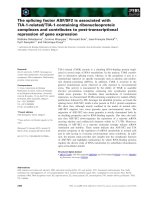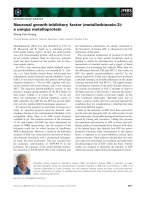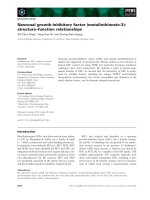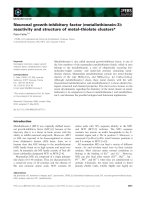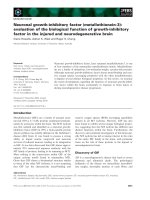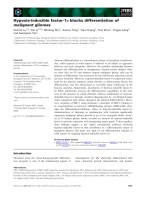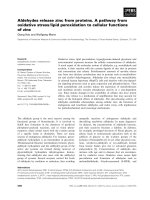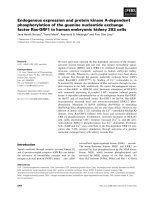Báo cáo khoa học: Hepatocyte growth factor activator (HGFA): a serine protease that links tissue injury to activation of hepatocyte growth factor pdf
Bạn đang xem bản rút gọn của tài liệu. Xem và tải ngay bản đầy đủ của tài liệu tại đây (237.64 KB, 7 trang )
MINIREVIEW
Hepatocyte growth factor activator (HGFA): a serine
protease that links tissue injury to activation of
hepatocyte growth factor
Keiji Miyazawa
Department of Biochemistry, Interdisciplinary Graduate School of Medicine and Engineering, University of Yamanashi, Japan
Introduction
In tissues of multicellular organisms, different types of
cells are intricately and precisely arranged to perform
specific functions. Once such tissue architecture is
destroyed, the regeneration system works to restore the
structure as well as the function of the damaged tissue.
Liver regeneration has long been a subject of active
research, because it displays a dramatic form of organ
regeneration. It also represents a good in vivo model
for understanding the regulation of cell growth:
hepatocytes are usually in a quiescent state, but most
of them enter the cell cycle during liver regeneration.
Humoral factors that trigger liver cell growth have
been detected in the blood circulation of liver-injured
animals, and many researchers have tried to isolate
these factors.
Hepatocyte growth factor (HGF) was originally
identified as a potent mitogen for hepatocytes in pri-
mary culture during studies of liver regeneration [1].
Studies showed that HGF was induced in the blood
plasma and liver in response to liver injury. Therefore,
Keywords
hepatocyte growth factor; plasminogen;
proteolytic activation; tissue injury
Correspondence
K. Miyazawa, Department of Biochemistry,
Interdisciplinary Graduate School of
Medicine and Engineering, University of
Yamanashi, 1110 Shimokato, Chuo,
Yamanashi 409-3898, Japan
Fax ⁄ Tel: +81 55 273 6784
E-mail:
(Received 26 November 2009, revised
3 February 2010, accepted 26 February
2010)
doi:10.1111/j.1742-4658.2010.07637.x
Growth factors are a group of proteins that regulate a wide variety of cel-
lular processes, including proliferation, differentiation, motility, adhesion,
and apoptosis of target cells. They play crucial roles in the formation and
maintenance of tissue architecture in embryonic development and adult
tissue homeostasis. Because aberrations in growth factor signaling often
result in pathological conditions, the activities of growth factors are tightly
controlled by extracellular and intracellular regulators. Hepatocyte growth
factor (HGF) is a mesenchymal cell-derived growth factor that affects
various target cells, including epithelial and endothelial cells. HGF is
synthesized and secreted as a latent form, and is proteolytically activated in
response to tissue injury, thus participating in tissue regeneration and
repair. Interestingly, HGF has a unique structural feature: it is homologous
to plasminogen, a key enzyme in the fibrinolytic system. Elucidation of the
regulatory mechanisms of HGF activity has revealed that a blood coagula-
tion factor XII-like serine protease, hepatocyte growth factor activator,
efficiently converts HGF from the latent form to the active form. Hepato-
cyte growth factor activator itself is activated downstream of the
blood coagulation cascade, and links tissue injury to activation of HGF.
HGF thus has structural as well as functional relevance to the blood
coagulation ⁄ fibrinolytic system.
Abbreviations
FXII, coagulation factor II; HGF, hepatocyte growth factor; HGFA, hepatocyte growth factor activator; tPA, tissue-type plasminogen activator.
2208 FEBS Journal 277 (2010) 2208–2214 ª 2010 The Author Journal compilation ª 2010 FEBS
HGF was regarded as the humoral factor that triggers
liver regeneration. HGF was subsequently shown to
have mitogenic, motogenic and morphogenic activities
on various target cells, including epithelial and endo-
thelial cells. HGF is now thought to play a major role
in the repair and regeneration of various tissues,
including the liver, kidney, lung, and stomach [1].
A new question then arose. Why is the liver specifi-
cally targeted to grow after liver injury? HGF and
its receptor, MET tyrosine kinase, are widely expressed
and distributed among normal as well as injured tis-
sues. After liver injury, HGF is induced not only in
the liver but also in blood plasma and other uninjured
tissues, such as spleen [2]. Although HGF is not exclu-
sively induced in the liver, its action is limited to the
injured liver. Apparently, the amount of HGF is not
correlated with the activity of HGF, suggesting that
HGF is latent in normal states, and is activated specifi-
cally at the site of tissue injury. The mechanism of
localized activation of HGF, however, had remained
unclear. In this minireview, I describe the discovery of
a novel serine protease, HGF activator (HGFA),
which has revealed the link between tissue injury and
localized activation of HGF.
Active and inactive forms of HGF
The first step in solving this puzzle was to understand
the nature of latent HGF. Several examples of latent
growth factors have already been reported. Insulin-like
growth factors are inactive when bound to insulin-like
growth factor-binding proteins. Transforming growth
factor-b is produced and secreted as a latent precursor
form composed of the N-terminal ‘latency-associated
peptide’ and the C-terminal mature form. It is
activated after the N-terminal portion of the precursor
is degraded or dissociated from the C-terminal portion.
In the case of HGF, its unique primary structure pro-
vided a valuable clue for solving the puzzle of HGF
latency.
Mature HGF consists of two polypeptide chains, a
heavy a-chain (62 kDa) and a light b-chain
(32–34 kDa), which are held together by a disulfide
bond [3]. In 1989, cDNA of human HGF was cloned,
and the primary structure was elucidated [4,5]. HGF is
synthesized and secreted as a single-chain precursor
[6], and is extracellularly processed to the two-chain
form by proteolytic cleavage at a specific site. The
heavy chain consists of four tandem repeats of a krin-
gle domain, and the light chain has a structure similar
to that of the catalytic domain of serine proteases
(Fig. 1A) [5]. HGF, however, has no proteolytic activ-
ity, because two of the conserved catalytic triad resi-
dues of the serine protease domain are substituted.
The domains of HGF are very similar to those of pro-
teases in the blood coagulation and fibrinolytic system.
HGF shows the highest similarity to plasminogen
(about 40% amino acid similarity).
Plasminogen is synthesized as a single-chain form
that consists of five tandemly repeated kringle domains
and a serine protease domain [1]. It is activated upon
cleavage at a specific site between the fifth kringle
Heavy chain (α-chain)
Light chain (β-chain)
62 kDa
32–34 kDa
Signal
1
I II III IV
2
(K)(N)
(N) (K)
(N)
NK1
NK2
I
I
II
(K)
A
B
Hairpin region
Kringle domain
Serine protease-
like domain
Fig. 1. Schematic structure of HGF (A) and
its variants (B). Circles denote amino acids,
and lines denote disulfide bonds. Arrow-
head 1 denotes the cleavage site of the
signal sequence. Arrowhead 2 denotes the
cleavage site for activation. Roman numbers
denote kringle domain numbers.
K. Miyazawa Hepatocyte growth factor activator
FEBS Journal 277 (2010) 2208–2214 ª 2010 The Author Journal compilation ª 2010 FEBS 2209
domain and the serine protease domain by the action
of either urokinase or tissue-type plasminogen activa-
tor (tPA). After this site-specific cleavage, the protease
domain changes conformation and becomes active.
Plasmin then degrades fibrin clots and extracellular
matrices, and activates matrix metalloproteases, thus
contributing to the process of tissue remodeling.
Similarly, the single-chain form of HGF was shown
to be a latent form. We found that single-chain HGF
was inactive in the presence of serine protease inhibi-
tors in a hepatocyte proliferation assay, whereas the
two-chain form was active even in the presence of the
inhibitors [7]. Furthermore, an HGF mutant, in which
Arg494 was replaced by glycine, and which was thus
resistant to proteolytic processing, was not active at all
[7,8]. HGF needs be processed to the two-chain form
to exert its biological activity. Recently, proteolytic
processing of HGF was shown to induce a conforma-
tional change in the serine protease-like domain, which
is required for functional interaction of HGF with its
receptor, MET, through a region corresponding to the
‘active site’ and ‘activation domain’ of serine proteases
[9,10]. HGF and serine proteases thus share a similar
activation mechanism.
Proteolytic activation of HGF in
response to tissue injury
In order to elucidate the in vivo roles of proteolytic
processing of HGF, we examined the molecular forms
of HGF by immunoblotting using a heavy chain-
specific monoclonal antibody [11]. The antibody reacts
with both the single-chain and two-chain forms of
HGF, giving positive bands at 92 and 62 kDa, respec-
tively. By scanning of the 92 and 62 kDa bands,
the ratio of the single-chain form (inactive) to the
two-chain form (active) can be quantified.
We first found that HGF from various normal rat
tissues (liver, kidney, lung, and spleen) was present
exclusively in the inactive single-chain form. We next
administered hepatotoxin or nephrotoxin to rats to
induce tissue injury. HGF was extracted from injured
and uninjured tissues and then analyzed. After intraga-
stric administration of carbon tetrachloride, liver tissue
was severely injured and the other tissues were mini-
mally affected. The amount of HGF was dramatically
increased in the liver and spleen tissue, but not in the
kidney or lung tissue. HGF was converted to the
active form only in the liver, which was injured in this
experimental model. Similar results were obtained
when d-galactosamine was used to induce liver injury
through a different mechanism. When we injected
mercuric chloride to induce renal injury in rats, HGF
in the kidney increased in quantity and was activated.
In contrast, HGF in the liver and spleen increased in
quantity but was not activated. These findings
indicated that HGF in uninjured tissue exists as the
inactive form, even though it sometimes increases in
amount. HGF is therefore activated exclusively in
injured tissues by proteolytic processing, and thus
seems to contribute to the process of tissue regenera-
tion and repair [11].
The fact that the proteolytic conversion of HGF is
specific to injured tissues suggests that HGF-convert-
ing enzyme(s) should work exclusively in the injured
tissues. We found that HGF-converting activity was
induced in the injured liver but not in the normal liver
tissue [11]. This activity seemed most likely to repre-
sent a key enzyme regulating the action of HGF in
injured tissues. We thought that identification of the
enzyme would be crucial to understanding the control
of HGF action in vivo. The activity of this enzyme,
however, was not high enough to allow purification of
the protein for identification. Fortunately, we detected
strong HGF-converting activity in human serum.
HGFA – one of the key enzymes of HGF
activation
We thus purified, from human serum, a novel serine
protease of 34 kDa that activates HGF very efficiently
in vitro, and designated it as HGFA [12]. The nucleo-
tide sequence of HGFA cDNA showed that HGFA is
derived from the C-terminal region of a precursor of
655 amino acids by proteolytic processing. Interest-
ingly, the precursor consists of multiple domains, a
type II fibronectin homology region, two epidermal
growth factor domains, a type I fibronectin homology
region, a kringle domain, and a catalytic domain
(Fig. 2). These domains are homologous to those
observed in blood coagulation factor XII (FXII), with
an overall amino acid similarity of 39%. Analysis of
genomic DNA coding for HGFA indicated a relation-
ship between HGFA and FXII as well as urokinase
and tPA, activators of plasminogen. These four pro-
teins therefore constitute a family (the PA–FXII–
HGFA family) [13].
Other proteases, such as urokinase, tPA, FXII,
factor XI, plasma kallikrein, matriptase, and hepsin,
were subsequently reported to activate HGF in vitro
[14–18]. The first five of these are of blood plasma ori-
gin, whereas the latter two are transmembrane serine
proteases and may be involved in pericellular activa-
tion of HGF. Among these proteases, matriptase and
hepsin activate HGF with comparable efficiency to
that of HGFA in vitro [17,18]. Although the activities
Hepatocyte growth factor activator K. Miyazawa
2210 FEBS Journal 277 (2010) 2208–2214 ª 2010 The Author Journal compilation ª 2010 FEBS
of the other proteases on HGF are very weak in vitro,
they may be stimulated by a cofactor(s) or by a certain
microenvironment in vivo. These proteases, as well as
HGFA, are thus candidates for the HGF-converting
enzyme in injured tissues.
Recently, Itoh and Kataoka generated mice defi-
cient in hgfa, and directly demonstrated that HGFA
is the serum-derived protease responsible for activa-
tion of HGF [19,20]. HGFA was also shown to be
required for tissue repair in experimental colitis mod-
els. Both HGF activation and tissue regeneration
were markedly impaired in injured intestinal tissue of
HGFA-deficient mice. The important function of
HGFA during tissue repair in vivo was thus demon-
strated.
How is HGFA activity localized to the
site of tissue injury?
HGFA is produced in liver parenchymal cells, and
behaves as an acute-phase protein [21]. HGFA is
found in the active form in serum, but in the inactive
form in plasma. This precursor form was purified and
characterized [22]. The inactive form of HGFA
(pro-HGFA) has a molecular mass of 96 kDa, and is
converted to its mature form by thrombin and
plasma kallikrein (KLKB1) [22] (Fig. 2). The process-
ing by thrombin is required for activating HGFA,
whereas that by plasma kallikrein is not. The role of
the processing by plasma kallikrein remains to be
elucidated.
HGFA circulates in the bloodstream as an inactive
precursor, and is activated in response to tissue injury,
probably coupled with activation of the blood coagula-
tion system. Immunoblotting analysis of HGFA from
normal and injured tissues indicated that HGFA is
activated exclusively in injured tissues [23]. Thus,
injured tissue-specific activation of HGFA appears to
be involved in the localized activation of HGF.
HGF was originally identified as a potent mitogen
for hepatocytes, but it was subsequently shown to
induce angiogenesis in vivo, and to stimulate prolifera-
tion ⁄ migration of vascular endothelial cells in vitro
[24,25]. HGF thus appears to be linked to the blood
coagulation and fibrinolytic system, not only structur-
ally but also functionally (Fig. 3). The blood coagula-
tion system is activated upon injury of blood vessels,
leading to conversion of prothrombin to thrombin.
Thrombin processes fibrinogen and coagulation fac-
tor XIII (plasma transglutaminase) to form stable
blood clots and prevent further hemorrhage from the
injured sites. Concomitantly, thrombin induces activa-
tion of HGF via HGFA. HGF then stimulates prolif-
eration and migration of endothelial cells to repair
blood vessels. It appears rational that the blood coagu-
lation system triggers activation of a growth factor
that promotes angiogenesis. Therefore, the prototypic
function of HGF may be to maintain the integrity of
blood vessels. Thrombin appears to be a bifurcation
point for clotting and endothelial cell migration ⁄ prolif-
eration, and HGFA represents the link between tissue
injury and activation of HGF.
Perspectives
In 1995, Uehara et al. and Bladt and coworkers [26,27]
reported that the embryonic lethality of HGF-knock-
Kringle
Type I
Type II
EGF EGF
1
(2)
Serine protease
Fig. 2. Schematic structure of HGFA. Circles denote amino acids,
and lines denote disulfide bonds. The names of the domains are
shown. Type I and Type II denote the type I fibronectin homology
region and the type II fibronectin homology region, respectively.
The arrowhead denotes the cleavage site of the signal sequence.
Arrow 1 denotes the site of cleavage by thrombin, kallikrein 1-
related peptidase 4, and kallikrein 1-related peptidase 5, which is
required for activation of HGFA. Arrow 2 denotes the site of cleav-
age by plasma kallikrein. EGF, epidermal growth factor.
Cell growth, migration
Pro-HGF HGF
Cell
FXa
Pro-HGFA HGFA
Thrombin
FVa
Prothrombin
FXIII
Fibrinogen fibrin
FXIIIa
Cross-linked fibrin clot
Fig. 3. Activation of HGF in response to tissue injury. Activation of
the blood coagulation cascade, through either an intrinsic or an
extrinsic pathway, results in conversion of prothrombin to thrombin.
Thrombin processes fibrinogen and factor XIII (FXIII; plasma trans-
glutaminase) to form stable blood clots and prevent further hemor-
rhage from the injured sites. Concomitantly, thrombin induces
activation of HGF via HGFA, which leads to endothelial cell
growth ⁄ migration and contributes to repair of the blood vessel
structure. HGF also stimulates the proliferation and migration of
epithelial cells to repair the tissue architecture. FVa, factor Va; FXa,
factor Xa; FXIIIa, activated FXIII.
K. Miyazawa Hepatocyte growth factor activator
FEBS Journal 277 (2010) 2208–2214 ª 2010 The Author Journal compilation ª 2010 FEBS 2211
out mice was caused by dysfunction of the placenta
and liver, indicating that HGF plays important roles
during embryonic development. We can explain the
activation of HGF in injured tissues in adults by the
scheme illustrated in Fig. 3, but it remains unclear
how HGF is activated during embryonic development
in which there is no apparent tissue injury. In the
Drosophila embryo, the signal transduction pathway
that establishes the dorsal–ventral pattern is temporally
and spatially regulated through the proteolytic cascade
to activate Spa
¨
tzle, the Toll receptor ligand [28]. It is
likely that a proteolytic cascade also plays an impor-
tant role in the regulation of HGF activity during
mammalian development. Known proteases that acti-
vate HGF in vitro do not appear to be the key prote-
ases activating HGF during embryonic development,
because mice lacking these proteases are not embry-
onic lethal. Alternatively, truncated variant forms of
HGF, NK1, and NK2 (Fig. 1B), which are abundantly
expressed in embryo-derived cells, might contribute to
HGF activity during embryonic development. These
variants exhibit weak agonistic activity, although they
lack the serine protease-like domain [29,30], and do
not appear to require proteolytic activation. Further
progress in this field would answer this question.
In chronic liver diseases, liver dysfunction often
leads to disorders in blood coagulation, because the
plasma levels of blood clotting enzymes, which are
produced in hepatocytes, are decreased. Similarly,
HGFA is produced in hepatocytes [21], and its produc-
tion is impaired in a rat model of liver cirrhosis, caus-
ing decreased efficiency of HGF activation [31].
Kaibori et al. [32] demonstrated that local administra-
tion of HGFA promotes conversion of HGF from the
inactive form to the active form, leading to accelera-
tion of liver regeneration. In other cases, aberrant
activation of HGF may result in overactivity of HGF,
which is implicated in malignancy as well as some
types of kidney disease (including polycystic disease,
glomerulosclerosis, and renal tubular hyperplasia) [33].
It is important to identify HGF-activating enzymes in
each pathogenic situation that is associated with aber-
rant HGF function. Selective inhibitors against those
enzymes, probably including HGFA, could be candi-
dates for clinical drugs for treatment of such diseases
with HGF overactivity.
We identified HGFA as a protease that links tissue
injury to activation of HGF. However, HGFA may
activate HGF in other contexts in vivo. Notably, the
kallikrein 1-related peptidases KLK-4 and KLK-5
were recently shown to activate HGFA [34]. These
proteases cleave HGFA at the same site as thrombin.
KLK-4 and KLK-5 are implicated in the activation of
HGFA in tumor tissues. Further investigation of
HGFA activation in vivo, as well as regulation of
HGFA activity by endogenous protease inhibitors,
including hepatocyte growth factor activator inhibitor-1
(HAI-1) and protein C inhibitor [35–37], will be
important for understanding the pathophysiological
processes regulated by the HGF–HGFA system.
Acknowledgements
I apologize to colleagues in the field for not citing
many important papers, because of the limitation of
the length of this review article. I would like to thank
T. Shimomura, D. Naka and T. Kawaguchi of Mitsu-
bishi Chemical Corp., A. Okajima and A. Kitamura of
Kansai Medical University and N. Kitamura of Tokyo
Institute of Technology for their contributions to the
study of HGFA.
References
1 Plasminogen-related Growth Factors (Chiba Foundation
Symposium 212) (Bock GR & Goode JA, eds) (1997)
Wiley, Chichester.
2 Okajima A, Miyazawa K & Kitamura N (1990)
Primary structure of rat hepatocyte growth factor and
induction of its mRNA during liver regeneration
following hepatic injury. Eur J Biochem 193, 375–381.
3 Gohda E, Tsubouchi H, Nakayama H, Hirono S,
Sakiyama O, Takahashi K, Miyazaki H, Hashimoto S
& Daikuhara Y (1988) Purification and partial charac-
terization of hepatocyte growth factor from plasma of a
patient with fulminant hepatic failure. J Clin Invest 81,
414–419.
4 Miyazawa K, Tsubouchi H, Naka D, Takahashi K,
Okigaki M, Arakaki N, Nakayama H, Hirono S,
Sakiyama O, Takahashi K et al. (1989) Molecular
cloning and sequence analysis of cDNA for human
hepatocyte growth factor. Biochem Biophys Res
Commun 163, 967–973.
5 Nakamura T, Nishizawa T, Hagiya M, Seki T,
Shimonishi M, Sugimura A, Tashiro K & Shimizu S
(1989) Molecular cloning and expression of human
hepatocyte growth factor. Nature 342, 440–443.
6 Miyazawa K, Kitamura A, Naka D & Kitamura N
(1991) An alternatively processed mRNA generated
from human hepatocyte growth factor gene. Eur J
Biochem 197, 15–22.
7 Naka D, Ishii T, Yoshiyama Y, Miyazawa K, Hara H,
Hishida T & Kitamura N (1992) Activation of hepatocyte
growth factor by proteolytic conversion of a single chain
form to a heterodimer. J Biol Chem 267, 20114–20119.
8 Lokker NA, Mark MR, Luis EA, Bennett GL, Rob-
bins KA, Baker JB & Godowski PJ (1992) Structure–
Hepatocyte growth factor activator K. Miyazawa
2212 FEBS Journal 277 (2010) 2208–2214 ª 2010 The Author Journal compilation ª 2010 FEBS
function analysis of hepatocyte growth factor: identifi-
cation of variants that lack mitogenic activity yet
retain high affinity receptor binding. EMBO J 11,
2503–2510.
9 Kirchhofer D, Yao X, Peek M, Eigenbrot C, Lipari
MT, Billeci KL, Maun HR, Moran P, Santell L,
Wiesmann C et al. (2004) Structural and functional
basis of the serine protease-like hepatocyte growth
factor b-chain in Met binding and signaling. J Biol
Chem 279, 39915–39924.
10 Kirchhofer D, Lipari MT, Santell L, Billeci K, Maun
HR, Sandoval WN, Moran P, Ridgway J, Eigenbrot C
& Lazarus RA (2007) Utilizing the activation mecha-
nism of serine proteases to engineer hepatocyte growth
factor into a Met antagonist. Proc Natl Acad Sci USA
104, 5306–5311.
11 Miyazawa K, Shimomura T, Naka D & Kitamura N
(1994) Proteolytic activation of hepatocyte growth fac-
tor in response to tissue injury. J Biol Chem 269, 8966–
8970.
12 Miyazawa K, Shimomura T, Kitamura A, Kondo J,
Morimoto Y & Kitamura N (1993) Molecular cloning
and sequence analysis of the cDNA for a human serine
protease responsible for activation of hepatocyte growth
factor. J Biol Chem 268, 10024–10028.
13 Miyazawa K, Wang Y, Minoshima S, Shimizu N &
Kitamura N (1998) Structural organization and chro-
mosomal localization of the human hepatocyte growth
factor activator gene. Phylogenetic and functional rela-
tionship with blood coagulation factor XII, urokinase,
and tissue-type plasminogen activator. Eur J Biochem
258, 355–361.
14 Naldini L, Tamagnone L, Vigna E, Sachs M, Hartmann
G, Birchmeier W, Daikuhara Y, Tsubouchi H, Blasi F
& Comoglio PM (1992) Extracellular proteolytic
cleavage by urokinase is required for activation of
hepatocyte growth factor ⁄ scatter factor. EMBO J 11,
4825–4833.
15 Shimomura T, Miyazawa K, Komiyama Y, Hiraoka
H, Naka D, Morimoto Y & Kitamura N (1995)
Activation of hepatocyte growth factor by two
homologous proteases, blood-coagulation factor XIIa
and hepatocyte growth factor activator. Eur J Biochem
229, 257–261.
16 Peek M, Moran P, Mendoza N, Wickramasinghe D &
Kirchhofer D (2002) Unusual proteolytic activation of
pro-hepatocyte growth factor by plasma kallikrein and
coagulation factor XIa. J Biol Chem 277, 47804–47809.
17 Lee SL, Dickson RB & Lin CY (2000) Activation of
hepatocyte growth factor and urokinase ⁄ plasminogen
activator by matriptase, an epithelial membrane serine
protease. J Biol Chem 275, 36720–36725.
18 Kirchhofer D, Peek M, Lipari MT, Billeci K, Fan B &
Moran P (2005) Hepsin activates pro-hepatocyte growth
factor and is inhibited by hepatocyte growth factor
activator inhibitor-1B (HAI-1B) and HAI-2. FEBS Lett
579, 1945–1950.
19 Itoh H, Naganuma S, Takeda N, Miyata S,
Uchinokura S, Fukushima T, Uchiyama S, Tanaka H,
Nagaike K, Shimormura T et al. (2004) Regeneration
of injured intestinal mucosa is impaired in hepatocyte
growth factor activator-deficient mice. Gastroenterology
127, 1423–1435.
20 Kataoka H & Kawaguchi M (2010) Hepatocyte
growth factor activator (HGFA): pathophysiological
functions in vivo. FEBS J 277, 2230–2237.
21 Okajima A, Miyazawa K, Naito Y, Inoue K & Kitam-
ura N (1997) Induction of hepatocyte growth factor
activator mRNA in the liver following tissue injury and
acute inflammation. Hepatology 25, 97–102.
22 Shimomura T, Kondo J, Ochiai M, Naka D, Miyazawa
K, Morimoto Y & Kitamura N (1993) Activation of
the zymogen of hepatocyte growth factor activator by
thrombin. J Biol Chem 268
, 22927–22932.
23 Miyazawa K, Shimomura T & Kitamura N (1996)
Activation of hepatocyte growth factor in the injured
tissues is mediated by hepatocyte growth factor
activator. J Biol Chem 271, 3615–3618.
24 Busolino F, Di Renzo MF, Ziche M, Bocchietto E,
Olivero M, Naldini L, Gaudino G, Tamagnone L,
Coffer A & Comoglio PM (1992) Hepatocyte growth
factor is a potent angiogenic factor which stimulates
endothelial motility and growth. J Cell Biol 119, 629–
641.
25 Grant DS, Kleinman HK, Goldberg ID, Bhargava
MM, Nickoloff BJ, Kinsella JL, Polverini P & Rosen
EM (1993) Scatter factor induces blood vessel forma-
tion in vivo. Proc Natl Acad Sci USA 90, 1937–1941.
26 Uehara Y, Minowa O, Mori C, Shiota K, Kuno J,
Noda T & Kitamura N (1995) Placental defect and
embryonic lethality in mice lacking hepatocyte growth
factor ⁄ scatter factor. Nature 373, 702–705.
27 Schmidt C, Bladt F, Goedecke S, Brinkmann V, Zschie-
sche W, Sharpe M, Gherardi E & Birchmeier C (1995)
Scatter factor ⁄ hepatocyte growth factor is essential for
liver development. Nature 373, 699–702.
28 Morisato D & Anderson KV (1994) The spa
¨
tzle gene
encodes a component of the extracellular signaling
pathway establishing the dorsal–ventral pattern of the
Drosophila embryo. Cell 76, 677–688.
29 Hartmann G, Naldini L, Weidner KM, Sachs M, Vigna
E, Comoglio PM & Birchmeier W (1992) A functional
domain in the heavy chain of scatter factor ⁄ hepatocyte
growth factor binds the c-Met receptor and induces cell
dissociation but not mitogenesis. Proc Natl Acad Sci
USA 89, 11574–11578.
30 Cioce V, Csaky KG, Chan AML, Bottaro DP, Taylor
WG, Jensen R, Aaronson SA & Rubin JS (1996)
Hepatocyte growth factor (HGF) ⁄ NK1 is a naturally
occurring HGF ⁄ scatter factor variant with partial
K. Miyazawa Hepatocyte growth factor activator
FEBS Journal 277 (2010) 2208–2214 ª 2010 The Author Journal compilation ª 2010 FEBS 2213
agonist ⁄ antagonist activity. J Biol Chem 271, 13110–
13115.
31 Kaibori M, Inoue T, Sakakura Y, Oda M, Nagahama
T, Kwon AH, Kamiyama Y, Miyazawa K & Okumura
T (2002) Impairment of activation of hepatocyte growth
factor precursor into its mature form in rats with liver
cirrhosis. J Surg Res 106, 108–114.
32 Kaibori M, Inoue T, Oda M, Naka D, Kawaguchi T,
Kitamura N, Miyazawa K, Kwon AH, Kamiyama Y &
Okumura T (2002) Exogenously administered HGF
activator augments liver regeneration through the pro-
duction of biologically active HGF. Biochem Biophys
Res Commun 290, 475–481.
33 Takayama H, LaRochelle WJ, Sabnis SG, Otsuka T &
Merlino G (1997) Renal tubular hyperplasia, polycystic
diseases, and glomerulosclerosis in transgenic mice
overexpressing hepatocyte growth factor ⁄ scatter factor.
Lab Invest 77, 131–138.
34 Mukai S, Fukushima T, Naka D, Tanaka H, Osada Y
& Kataoka H (2008) Activation of hepatocyte growth
factor activator zymogen (pro-HGFA) by human kallik-
rein 1-related peptidases. FEBS J 275, 1003–1017.
35 Shimomura T, Denda K, Kitamura A, Kawaguchi T,
Kito M, Kondo J, Kagaya S, Qin L, Takata H, Miyaz-
awa K et al. (1997) Hepatocyte growth factor activator
inhibitor, a novel Kunitz-type serine protease inhibitor.
J Biol Chem 272, 6370–6376.
36 Eigenbrot C, Ganesan E & Kirchhofer D (2010)
Hepatocyte growth factor activator (HGFA): molecular
structure and interactions with HAI-1. FEBS J 277,
2215–2222.
37 Suzuki K (2010) Hepatocyte growth factor activator
(HGFA): its regulation by protein C inhibitor. FEBS J
277, 2223–2229.
Hepatocyte growth factor activator K. Miyazawa
2214 FEBS Journal 277 (2010) 2208–2214 ª 2010 The Author Journal compilation ª 2010 FEBS


